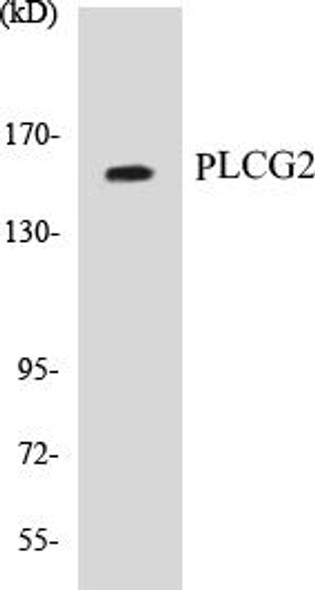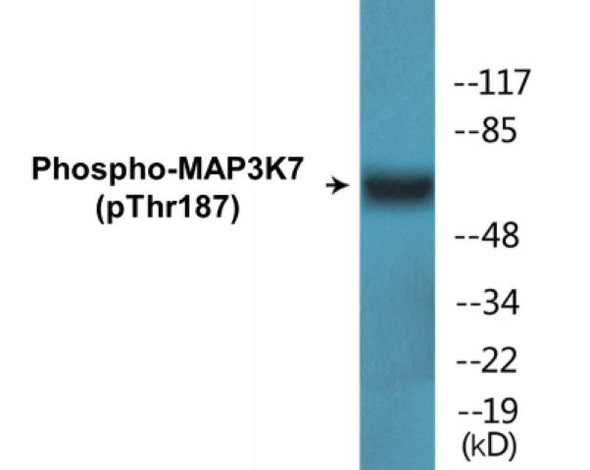Description
PLCG2 (Phospho-Tyr1217)Colorimetric Cell-Based ELISA Kit
The PLCG2 Phospho-Tyr1217 Colorimetric Cell-Based ELISA Kit from Assay Genie is a cutting-edge tool for studying the phosphorylation of PLCG2 at tyrosine 1217 in cell-based assays. By accurately measuring the levels of phosphorylated PLCG2, researchers can gain valuable insights into signal transduction pathways and cellular responses.This kit offers high sensitivity and specificity, allowing for precise and reliable detection of PLCG2 phosphorylation in a variety of cell types and experimental conditions. With its easy-to-follow protocol and quick results, this kit is perfect for researchers looking to investigate the role of PLCG2 in cell signaling, immune response, and disease development.
Whether studying cancer, immune disorders, or inflammatory conditions, the PLCG2 Phospho-Tyr1217 Colorimetric Cell-Based ELISA Kit is a valuable tool for analyzing the phosphorylation status of PLCG2 and understanding its impact on cellular function. Trust Assay Genie for accurate and trustworthy results in your research endeavors.
| Product Name: | PLCG2 (Phospho-Tyr1217) Colorimetric Cell-Based ELISA |
| Product Code: | CBCAB00427 |
| ELISA Type: | Cell-Based |
| Target: | PLCG2 (Phospho-Tyr1217) |
| Reactivity: | Human, Mouse, Rat |
| Dynamic Range: | > 5000 Cells |
| Detection Method: | Colorimetric 450 nm |
| Format: | 2 x 96-Well Microplates |
The PLCG2 (Phospho-Tyr1217) Colorimetric Cell-Based ELISA Kit is a convenient, lysate-free, high throughput and sensitive assay kit that can detect PLCG2 protein phosphorylation and expression profile in cells. The kit can be used for measuring the relative amounts of phosphorylated PLCG2 in cultured cells as well as screening for the effects that various treatments, inhibitors (ie. siRNA or chemicals), or activators have on PLCG2 phosphorylation.
Qualitative determination of PLCG2 (Phospho-Tyr1217) concentration is achieved by an indirect ELISA format. In essence, PLCG2 (Phospho-Tyr1217) is captured by PLCG2 (Phospho-Tyr1217)-specific primary antibodies while the HRP-conjugated secondary antibodies bind the Fc region of the primary antibody. Through this binding, the HRP enzyme conjugated to the secondary antibody can catalyze a colorimetric reaction upon substrate addition. Due to the qualitative nature of the Cell-Based ELISA, multiple normalization methods are needed:
| 1. | A monoclonal antibody specific for human GAPDH is included to serve as an internal positive control in normalizing the target absorbance values. |
| 2. | Following the colorimetric measurement of HRP activity via substrate addition, the Crystal Violet whole-cell staining method may be used to determine cell density. After staining, the results can be analysed by normalizing the absorbance values to cell amounts, by which the plating difference can be adjusted. |
| Database Information: | Gene ID: 5336, UniProt ID: P16885, OMIM: 600220, Unigene: Hs.413111 |
| Gene Symbol: | PLCG2 |
| Sub Type: | Phospho |
| UniProt Protein Function: | PLCG2: a calcium dependent phosphatidylinositol-specific phospholipase C. The activated enzyme produces the second messenger molecules diacylglycerol and inositol 1,4,5-trisphosphate. It is a crucial enzyme in transmembrane signaling. Phosphorylated and activated by tyrosine kinases in response to signaling through a variety of growth factor receptors and immune system receptors. |
| UniProt Protein Details: | Protein type:Carbohydrate Metabolism - inositol phosphate; Phospholipase; EC 3.1.4.11; Motility/polarity/chemotaxis Chromosomal Location of Human Ortholog: 16q24.1 Cellular Component: plasma membrane; cytosol Molecular Function:signal transducer activity; protein binding; phospholipase C activity; phosphoinositide phospholipase C activity Biological Process: platelet activation; Wnt receptor signaling pathway; inositol phosphate metabolic process; phospholipid catabolic process; calcium-mediated signaling; response to lipopolysaccharide; T cell receptor signaling pathway; activation of store-operated calcium channel activity; B cell receptor signaling pathway; regulation of gene expression; inositol trisphosphate biosynthetic process; B cell differentiation; release of sequestered calcium ion into cytosol; negative regulation of programmed cell death; phosphatidylinositol biosynthetic process; innate immune response; follicular B cell differentiation; blood coagulation Disease: Autoinflammation, Antibody Deficiency, And Immune Dysregulation, Plcg2-associated; Familial Cold Autoinflammatory Syndrome 3 |
| NCBI Summary: | The protein encoded by this gene is a transmembrane signaling enzyme that catalyzes the conversion of 1-phosphatidyl-1D-myo-inositol 4,5-bisphosphate to 1D-myo-inositol 1,4,5-trisphosphate (IP3) and diacylglycerol (DAG) using calcium as a cofactor. IP3 and DAG are second messenger molecules important for transmitting signals from growth factor receptors and immune system receptors across the cell membrane. Mutations in this gene have been found in autoinflammation, antibody deficiency, and immune dysregulation syndrome and familial cold autoinflammatory syndrome 3. [provided by RefSeq, Mar 2014] |
| UniProt Code: | P16885 |
| NCBI GenInfo Identifier: | 215274231 |
| NCBI Gene ID: | 5336 |
| NCBI Accession: | P16885.4 |
| UniProt Secondary Accession: | P16885,Q3ZTS2, Q59H45, Q969T5, D3DUL3, |
| UniProt Related Accession: | P16885 |
| Molecular Weight: | 1265 |
| NCBI Full Name: | 1-phosphatidylinositol 4,5-bisphosphate phosphodiesterase gamma-2 |
| NCBI Synonym Full Names: | phospholipase C, gamma 2 (phosphatidylinositol-specific) |
| NCBI Official Symbol: | PLCG2 |
| NCBI Official Synonym Symbols: | FCAS3; APLAID; PLC-IV; PLC-gamma-2 |
| NCBI Protein Information: | 1-phosphatidylinositol 4,5-bisphosphate phosphodiesterase gamma-2; phospholipase C-IV; phosphoinositide phospholipase C-gamma-2 |
| UniProt Protein Name: | 1-phosphatidylinositol 4,5-bisphosphate phosphodiesterase gamma-2 |
| UniProt Synonym Protein Names: | Phosphoinositide phospholipase C-gamma-2; Phospholipase C-IV; PLC-IV; Phospholipase C-gamma-2; PLC-gamma-2 |
| Protein Family: | 1-phosphatidylinositol 4,5-bisphosphate phosphodiesterase |
| UniProt Gene Name: | PLCG2 |
| UniProt Entry Name: | PLCG2_HUMAN |
| Component | Quantity |
| 96-Well Cell Culture Clear-Bottom Microplate | 2 plates |
| 10X TBS | 24 mL |
| Quenching Buffer | 24 mL |
| Blocking Buffer | 50 mL |
| 15X Wash Buffer | 50 mL |
| Primary Antibody Diluent | 12 mL |
| 100x Anti-Phospho Target Antibody | 60 µL |
| 100x Anti-Target Antibody | 60 µL |
| Anti-GAPDH Antibody | 60 µL |
| HRP-Conjugated Anti-Rabbit IgG Antibody | 12 mL |
| HRP-Conjugated Anti-Mouse IgG Antibody | 12 mL |
| SDS Solution | 12 mL |
| Stop Solution | 24 mL |
| Ready-to-Use Substrate | 12 mL |
| Crystal Violet Solution | 12 mL |
| Adhesive Plate Seals | 2 seals |
The following materials and/or equipment are NOT provided in this kit but are necessary to successfully conduct the experiment:
- Microplate reader able to measure absorbance at 450 nm and/or 595 nm for Crystal Violet Cell Staining (Optional)
- Micropipettes with capability of measuring volumes ranging from 1 µL to 1 ml
- 37% formaldehyde (Sigma Cat# F-8775) or formaldehyde from other sources
- Squirt bottle, manifold dispenser, multichannel pipette reservoir or automated microplate washer
- Graph paper or computer software capable of generating or displaying logarithmic functions
- Absorbent papers or vacuum aspirator
- Test tubes or microfuge tubes capable of storing ≥1 ml
- Poly-L-Lysine (Sigma Cat# P4832 for suspension cells)
- Orbital shaker (optional)
- Deionized or sterile water
*Note: Protocols are specific to each batch/lot. For the correct instructions please follow the protocol included in your kit.
| Step | Procedure |
| 1. | Seed 200 µL of 20,000 adherent cells in culture medium in each well of a 96-well plate. The plates included in the kit are sterile and treated for cell culture. For suspension cells and loosely attached cells, coat the plates with 100 µL of 10 µg/ml Poly-L-Lysine (not included) to each well of a 96-well plate for 30 minutes at 37°C prior to adding cells. |
| 2. | Incubate the cells for overnight at 37°C, 5% CO2. |
| 3. | Treat the cells as desired. |
| 4. | Remove the cell culture medium and rinse with 200 µL of 1x TBS, twice. |
| 5. | Fix the cells by incubating with 100 µL of Fixing Solution for 20 minutes at room temperature. The 4% formaldehyde is used for adherent cells and 8% formaldehyde is used for suspension cells and loosely attached cells. |
| 6. | Remove the Fixing Solution and wash the plate 3 times with 200 µL 1x Wash Buffer for five minutes each time with gentle shaking on the orbital shaker. The plate can be stored at 4°C for a week. |
| 7. | Add 100 µL of Quenching Buffer and incubate for 20 minutes at room temperature. |
| 8. | Wash the plate 3 times with 1x Wash Buffer for 5 minutes each time. |
| 9. | Add 200 µL of Blocking Buffer and incubate for 1 hour at room temperature. |
| 10. | Wash 3 times with 200 µL of 1x Wash Buffer for 5 minutes each time. |
| 11. | Add 50 µL of 1x primary antibodies Anti-PLCG2 (Phospho-Tyr1217) Antibody, Anti-PLCG2 Antibody and/or Anti-GAPDH Antibody) to the corresponding wells, cover with Parafilm and incubate for 16 hours (overnight) at 4°C. If the target expression is known to be high, incubate for 2 hours at room temperature. |
| 12. | Wash 3 times with 200 µL of 1x Wash Buffer for 5 minutes each time. |
| 13. | Add 50 µL of 1x secondary antibodies (HRP-Conjugated AntiRabbit IgG Antibody or HRP-Conjugated Anti-Mouse IgG Antibody) to corresponding wells and incubate for 1.5 hours at room temperature. |
| 14. | Wash 3 times with 200 µL of 1x Wash Buffer for 5 minutes each time. |
| 15. | Add 50 µL of Ready-to-Use Substrate to each well and incubate for 30 minutes at room temperature in the dark. |
| 16. | Add 50 µL of Stop Solution to each well and read OD at 450 nm immediately using the microplate reader. |
(Additional Crystal Violet staining may be performed if desired – details of this may be found in the kit technical manual.)






